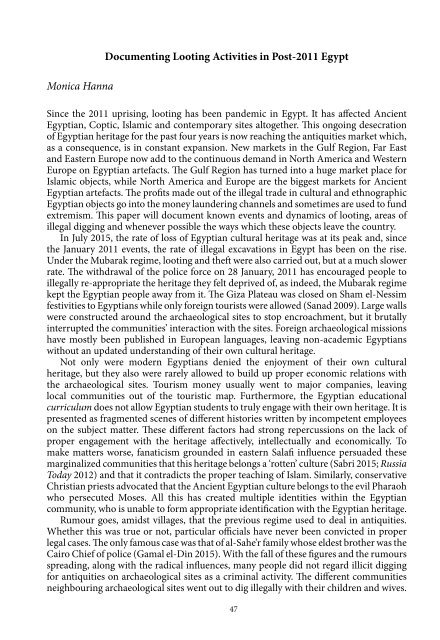Countering
Book_observatory_illicit_traffic_version%20issuu
Book_observatory_illicit_traffic_version%20issuu
You also want an ePaper? Increase the reach of your titles
YUMPU automatically turns print PDFs into web optimized ePapers that Google loves.
Monica Hanna<br />
Indeed, children have been used primarily to reach small burial shafts and tunnels.<br />
Unfortunately, many children have lost their lives in the process (Custodian 2015).<br />
People have become obsessed with finding a treasure that would make them rich quickly.<br />
Many people, particularly in Middle Egypt and the oases, started defrauding schemes as<br />
fake artefacts were buried for rich buyers to come and find – many of whom (from Egypt<br />
and abroad) were victims of these frauds.<br />
Another type of criminal looting activity has emerged. With the chaotic situation<br />
in Libya and the infiltration of state-of-the-art weapons through the western border of<br />
Egypt, many organized looting gangs were able to buy weapons at cheap prices. They<br />
immediately formed systematic groups to raid archaeological sites with four wheel cars<br />
and geo-sonars. Helpless site guards stood with their empty .9 mm pistols, watching<br />
gangs fight and kill each other over a discovered tomb. These gangs have archaeological<br />
knowledge, and many foreign experts were rumoured to have helped them with maps or<br />
with expertise. They also are thought to have worked for particular dealers or collectors<br />
who went in search of specific artefacts (Abdelzaher in Hanna 2004).<br />
With the Arab Spring and subsequent unrest in the Middle East, the trade in illicit<br />
antiquities has escalated. International crime organizations managed to smuggle<br />
antiquities along with arms and drugs in the region. Countries such as Israel, where the<br />
antiquities trade is legal, have served as a collection point for many objects in the region<br />
before travelling to Europe or the United States. Antiquities, from Ancient, Coptic,<br />
Islamic and Modern Egypt, started appearing on the antiquities market. In fact, the<br />
market suddenly flourished with thousands of objects coming in from illicit digging. The<br />
online market prospered in particular, as online websites have been used to sell Egyptian<br />
objects. In addition, a growing interest for collecting in the Gulf countries has emerged.<br />
The illegal markets in Abu Dhabi, Doha and Kuwait City had antiquities shops which<br />
collected objects that originated from the entire region. The famous Barakat Gallery<br />
has been selling illegally acquired objects in Abu Dhabi despite efforts by the Egyptian<br />
government to halt them.<br />
Illicit digging has destroyed most of the Egyptian heritage, as looters used bulldozers<br />
to tear off remains in their search for objects to be sold easily. Many of the sites have lost<br />
their historic value, insofar as the looters and local communities alike knew many of the<br />
spots where no excavations had taken place before and targeted them immediately. Illicit<br />
digging strips the object from any related contextual knowledge and as such, it becomes<br />
an artefact instead of a historical piece (Brodie 2006; Kanawati, El-Raziq and McFarlane<br />
1998). The looters not only sell de-contextualized objects, but also destroy the context of<br />
the site in the process. In most looted sites, many of the standing structures have been<br />
destroyed, such as at Antinoupolis (Shaykh Ibada) in Mallawi, Minya in Middle Egypt<br />
(Fig. 1).<br />
The looting, thefts, vandalism and land-grabbing map<br />
It is important to bear in mind the clear difference between looting and thefts. Looting<br />
targets unspoilt sites to extract objects and selling them. are usually armed and target<br />
magazines, storehouses and museums. Vandalism is usually carried out either to wipe<br />
out the aura of a site as ‘heritage’ by setting it on fire, destroying inscriptions, or turning<br />
the site into farmland, fish farms or a solid waste dump. This step usually is taken to<br />
change the ‘identity’ of the site in communal memory, so that its initial nature as an<br />
archaeological site is forgotten and its overtaking easier. Land-grabbing is usually the<br />
48


